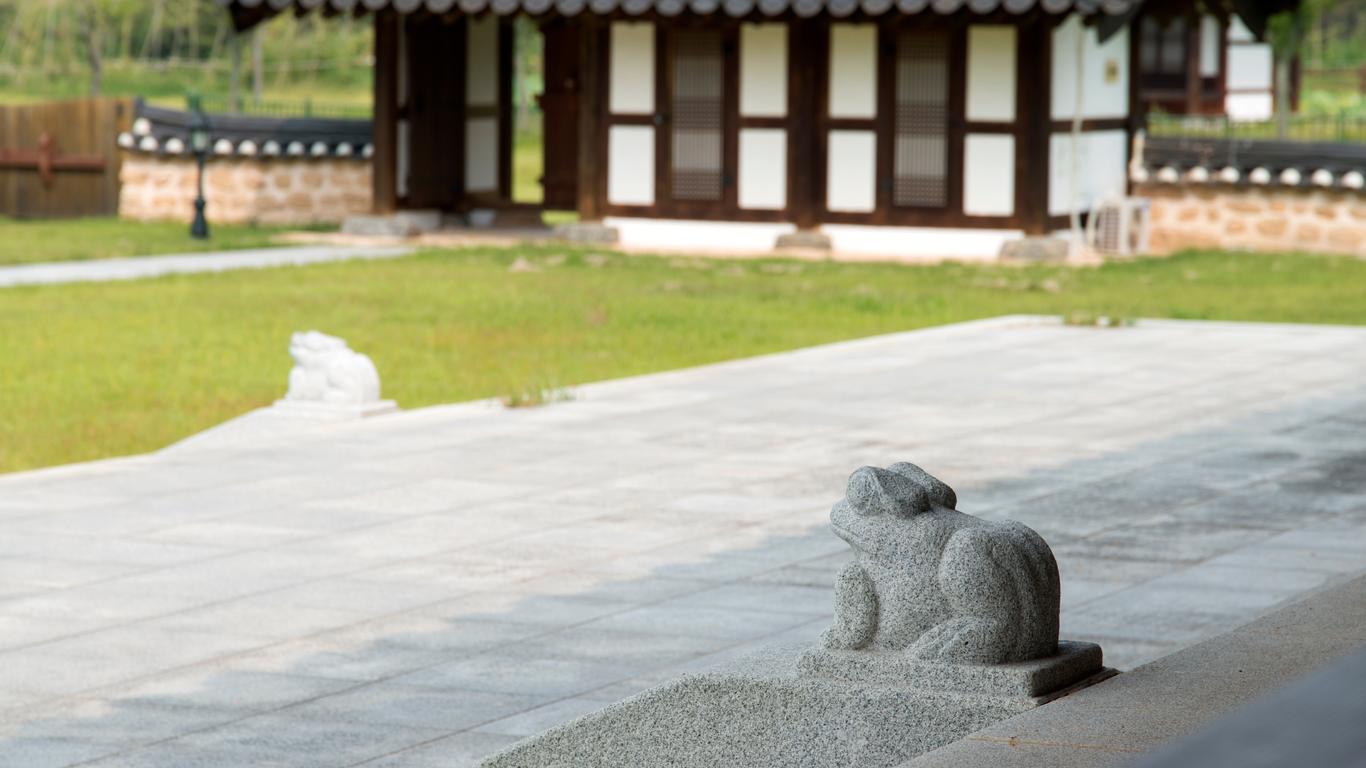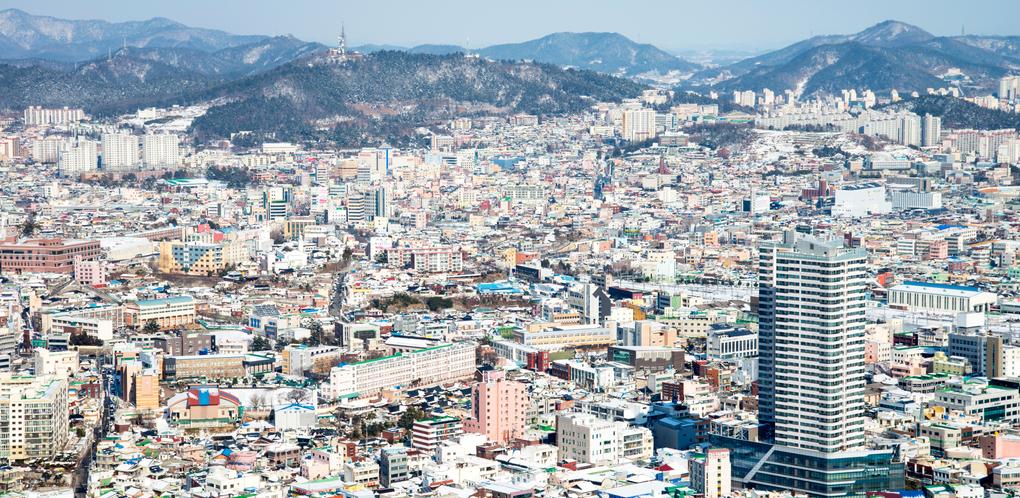
Gwangju travel guide
Gwangju Tourism | Gwangju Guide
You're Going to Love Gwangju
Gwangju has a trendy, thriving youth culture and, because of this, it's home to a whole host of clubs, bars, nightlife, shopping, and restaurants. Visitors will also love eating their way through the "breadbasket" of South Korea.

Top 5 Reasons to Visit Gwangju
1. Tiptoe through the Tea Fields
Photographers and travelers alike will really enjoy the day trip to the Boseong Green Tea Fields, a lush and beautiful landscape of tea plantations as far as the eye can see.
2. Visit the 5.18 Memorial Park
Witness Gwangju's democratic history at the quiet and picturesque 5.18 Memorial Park. A multitude of statues commemorate Gwangju's democratic resistance movement that occurred on May 18, 1980.
3. Step into the Serenity of Daewonsa
Sit in the pagoda and listen to the serene stream flowing by as serenity and distinct Asian architecture envelopes you at the Daewonsa temple, dedicated to Tibetan Buddhism.
4. Hike through the Beautiful Mudeungsan National Park
One of many national parks and home to multiple gorgeous temples, Mudeungsan is visited by picnicking families and hikers looking for the Yongchu Waterfall.
5. Wander and Wonder at the Beauty of Art Street
If you're an art lover, don't miss this entire street dedicated to urban art, artists, and galleries.
What to do in Gwangju
1. Discover Korea's Creative Hub
As you'll no doubt find out when you arrive, Gwangju is very much an artistic city these days, with creativity powering its recent renaissance. The Museum of Art is at the heart of this flowering, being run by the same team that stages the city's popular Biennale of art. It's a great place to find out about modern Korean artists, with its emphasis on active creators, as well as some more famous names like Uijae. If you like what you see from Uijae, it's worth noting that there's also a museum dedicated to his work just down the street.
2. An Easy Climb To Stunning Views
Soaring to a height of 1,186 meters, Mudeungsan dominates the skyline in Gwangju, and it's also at the heart of a beautiful national park. Thanks to its relatively gentle incline for such a tall peak, it's not a hard climb for active vacationers, but if you don't fancy the ascent, the temples at Yaksaam, Jeungsimsa, and Wonhyosa are gathered around the lower slopes. Otherwise, paths wind around the mountain, and beauty spots include Baekma Ridge - a real photo opportunity if there ever was one.
3. Everything You Need To Know About Gwangju's Past
Located on the lower slopes of Mudeungsan, the National Museum is full of intriguing exhibits and always repays a visitor's time. Created in 1977 to promote the city's culture, it has a fascinating array of artifacts from the Silla era (around 600-700 AD), along with items recovered from nearby shipwrecks, and plenty of sumptuous Buddhist sculptures. The region has an ancient past, and this museum tells the story comprehensively. In fact, its 3,300 square meters make it hard work to see everything.
4. Snag Some Artistic Bargains
Once upon a time, Daein-sijang was a traditional market which was slowly decaying and close to closure. However, the artistic wave then swept through Gwangju, and the area became a hotspot for galleries and craft stalls. Sparked by its use as a center for the Biennale, the market has now become the number one place to peruse the creations of local artists and buy a few pieces to take back home. And with this success has come some nifty cafes and restaurants as well.
5. Honoring Democratic Martyrs
In 1980, Gwangju briefly captured headlines across the world when a student protest was brutally suppressed by South Korea's dictatorship, and local people rose up, challenging the government. Hundreds of people were killed (we don't know exactly how many), but they have not been forgotten. This poignant memorial, which is around 30 minutes by bus from the city center, honors their democratic sacrifice, and is a holy site for modern Koreans. There's an on-site museum which leads visitors through the events of the uprising, and some powerful artifacts like bloodied Korean flags.
1. Discover Korea's Creative Hub
As you'll no doubt find out when you arrive, Gwangju is very much an artistic city these days, with creativity powering its recent renaissance. The Museum of Art is at the heart of this flowering, being run by the same team that stages the city's popular Biennale of art. It's a great place to find out about modern Korean artists, with its emphasis on active creators, as well as some more famous names like Uijae. If you like what you see from Uijae, it's worth noting that there's also a museum dedicated to his work just down the street.
2. An Easy Climb To Stunning Views
Soaring to a height of 1,186 meters, Mudeungsan dominates the skyline in Gwangju, and it's also at the heart of a beautiful national park. Thanks to its relatively gentle incline for such a tall peak, it's not a hard climb for active vacationers, but if you don't fancy the ascent, the temples at Yaksaam, Jeungsimsa, and Wonhyosa are gathered around the lower slopes. Otherwise, paths wind around the mountain, and beauty spots include Baekma Ridge - a real photo opportunity if there ever was one.
3. Everything You Need To Know About Gwangju's Past
Located on the lower slopes of Mudeungsan, the National Museum is full of intriguing exhibits and always repays a visitor's time. Created in 1977 to promote the city's culture, it has a fascinating array of artifacts from the Silla era (around 600-700 AD), along with items recovered from nearby shipwrecks, and plenty of sumptuous Buddhist sculptures. The region has an ancient past, and this museum tells the story comprehensively. In fact, its 3,300 square meters make it hard work to see everything.
4. Snag Some Artistic Bargains
Once upon a time, Daein-sijang was a traditional market which was slowly decaying and close to closure. However, the artistic wave then swept through Gwangju, and the area became a hotspot for galleries and craft stalls. Sparked by its use as a center for the Biennale, the market has now become the number one place to peruse the creations of local artists and buy a few pieces to take back home. And with this success has come some nifty cafes and restaurants as well.
5. Honoring Democratic Martyrs
In 1980, Gwangju briefly captured headlines across the world when a student protest was brutally suppressed by South Korea's dictatorship, and local people rose up, challenging the government. Hundreds of people were killed (we don't know exactly how many), but they have not been forgotten. This poignant memorial, which is around 30 minutes by bus from the city center, honors their democratic sacrifice, and is a holy site for modern Koreans. There's an on-site museum which leads visitors through the events of the uprising, and some powerful artifacts like bloodied Korean flags.
Where to Eat in Gwangju
Chow down on American-style pizza at Orange Brothers Pizza for ₩3,500 per slice. Or visit Jeongjagol for beef ribs and bulgogi for ₩13,000-₩28,000.
When to visit Gwangju
Visit Gwangju year round but pack your galoshes and rain coats! The city experiences a temperate climate but also heavy rainfall. Temperatures average 60 degrees.
How to Get to Gwangju
Plane
Gwanju Airport (KWJ) only offers flights to Seoul Gimpo and Jeju Airport, and will be phased out. Instead, land at Seoul Incheon Airport and take a direct bus for ₩29,600.
Train
Coming in from Seoul, Korail and KTX trains are the fastest options. The trip takes two hours and costs ₩46,800-47,100. Services arrive at the Gwangju Songjeong Station in the city's center.
Car
Driving from Seoul to Gwangju is an easy and straightforward trip. Simply drive south on Route 25, the Honam Expressway, for around 3.5 hours.
Bus
Gwangju's U-Square is the the largest and most modern bus terminal in South Korea. Standard buses cost ₩9,000 and limousine buses charge ₩28,200 for a journey from Seoul.
Airlines serving Gwangju
Where to stay in Gwangju
Bongseon - witness a diverse crowd and experience fun and trendy outdoor restaurants in this Gwangju neighborhood.
Popular Neighborhoods in Gwangju
Juwoldong - this neighborhood has pedestrian paths cut into sloping mountains and urban storefronts.
Nam-gu - experience a more "country" feeling in this neighborhood with its own small city center and serene spas.
Where to stay in popular areas of Gwangju
Most booked hotels in Gwangju
How to Get Around Gwangju
Public Transportation
Get around by either bus or subway. The latter costs ₩1,200 to any location. Buses are sorted by color: red for express buses; yellow for standard; green for village buses; and purple for the suburbs. Fares are ₩1,200 for adults, with a ₩100 discount when you use a Mybi or Han-Pay card.
Taxi
Taxis are cheap but watch out for rush hour traffic. Fares are ₩2,800 for the first 1.2 miles and then ₩100 after that.
Car
You can rent a car to visit the surrounding cities and drive in Gwangju from popular providers like Avis for ₩87,210 per day.
The Cost of Living in Gwangju
Shopping Streets
For those looking for deals on food, clothing, and furniture, don't miss the bright lights and busy crowds of Yangdong Market.
Groceries and Other
A quart of milk costs ₩2,500 and a dozen eggs cost ₩3,000.
